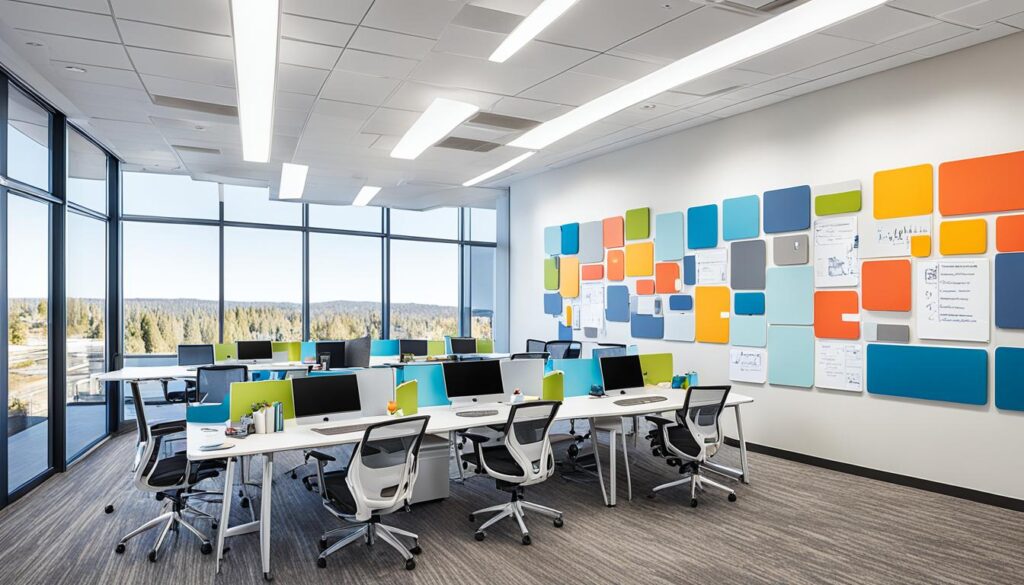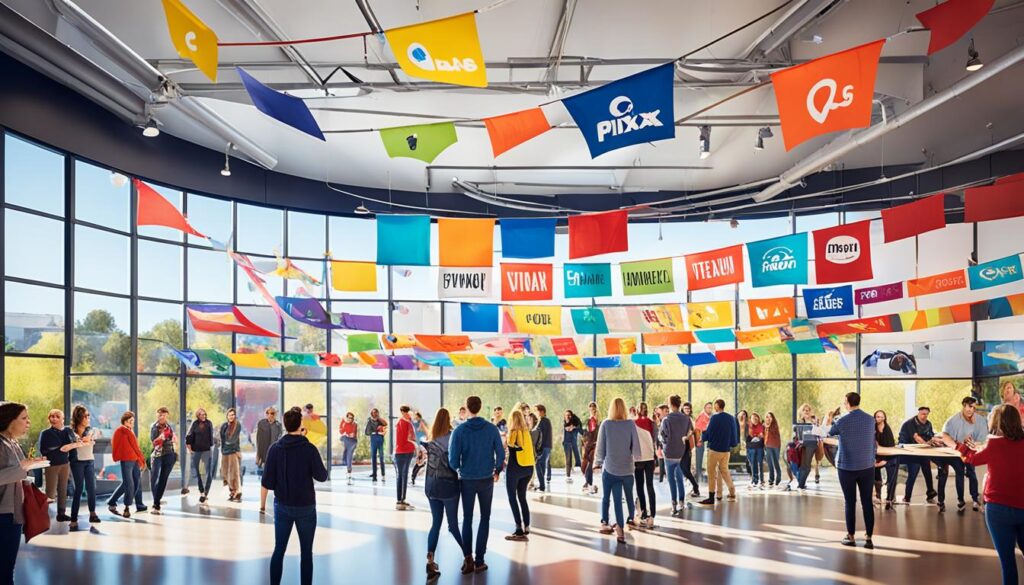In the modern business landscape, the design of the workspace has evolved to become a strategic tool that can significantly impact productivity, innovation, and overall success. By implementing collaborative workplace design principles, companies can boost team collaboration, improve team communication, enhance teamwork, foster collaboration within teams, promote effective collaboration, strengthen team dynamics, encourage teamwork and collaboration, optimize team collaboration, streamline team collaboration, and enhance team productivity.
Embracing the new paradigms of work, organizations are reimagining their office spaces to create environments that inspire creativity, enhance teamwork, and drive growth. The metamorphosis of workspace design has seen a shift from isolated cubicles to fluid, adaptable, and inclusive spaces that foster communication, knowledge exchange, and collaboration.
Inspiration can be drawn from successful organizations such as Disney and Pixar Animation Studios, which have embraced collaborative workspaces to achieve storytelling brilliance and cinematic triumphs. By implementing key tenets of collaborative design, including fluid spaces, informal hubs, innovative technology, diversity-driven inclusivity, and the cross-pollination of expertise, organizations can ignite a cultural transformation that values open dialogue, knowledge-sharing, and mutual respect.
In the contemporary business landscape, where remote and hybrid work setups are becoming increasingly prevalent, nurturing collaboration is more important than ever. By joining the collaborative revolution and adopting collaborative workspace design principles, organizations can empower teams, invigorate innovation, and position themselves for enduring success.
The Metamorphosis of Workspace Design
In the past, workplaces were often characterized by isolated cubicles and rigid structures. However, the concept of workspace design has evolved, and organizations now seek to create fluid, adaptable, and inclusive spaces that foster communication, knowledge exchange, and collaboration. The design of the workspace has become a deliberate process aligned with the vision and values of the organization. This shift in workplace design reflects the understanding that the physical environment plays a crucial role in shaping productivity, innovation, and overall success.
Today, collaborative workplace design has emerged as a strategic tool for enhancing productivity and driving growth. By creating environments that inspire creativity and enhance teamwork, organizations can unlock the full potential of their teams and achieve remarkable outcomes. The importance of workplace aesthetics cannot be overstated, as visually appealing and functional spaces have a profound impact on employee engagement, happiness, and overall job satisfaction.
Collaborative workplace design goes beyond the mere arrangement of furniture and layout of office spaces. It takes into account the multifaceted needs of diverse teams and aligns the physical environment with organizational goals and values. By incorporating elements that facilitate spontaneous interactions, encourage idea-sharing, and foster a sense of belonging, organizations can create environments that nurture innovation and collaboration.
One key aspect of collaborative workplace design is the integration of technology. Innovative tools and software enable seamless communication, efficient knowledge exchange, and remote collaboration, even in hybrid work environments. By leveraging technology, organizations can create spaces that transcend physical boundaries and foster collaboration on a global scale.
The impact of collaborative workplace design can be witnessed in successful organizations across different industries. Companies like Google, Apple, and Amazon have embraced innovative workspace design principles to create environments that inspire their employees and drive their success. These organizations understand that investing in an engaging and collaborative workspace is an investment in their people and their future.
The Advantages of Collaborative Workspace Design
The advantages of collaborative workspace design are numerous:
- Enhanced teamwork and collaboration
- Increased productivity and efficiency
- Improved employee satisfaction and morale
- Greater employee engagement and creativity
- Boosted innovation and problem-solving
- Effective knowledge sharing and cross-functional collaboration
By creating environments that inspire creativity, enhance teamwork, and drive growth, collaborative workspace design has become an indispensable tool for organizations striving to thrive in today’s dynamic business landscape.

Learning from Pixar’s Impact at Disney
Disney’s partnership with Pixar serves as a powerful example of the transformative potential of collaborative workplace design. When Disney faced challenges in its animation division, it turned to Pixar for inspiration. Pixar’s headquarters, known as Pixar Animation Studios, was renowned for its collaborative workspaces that fostered spontaneous interactions, cross-disciplinary idea-sharing, and limitless imagination.
By implementing similar collaborative design principles within its animation division, Disney revitalized its workspace and unleashed a renaissance of creativity. The result? The creation of cinematic triumphs such as “Tangled,” “Frozen,” and “Moana,” which captivated audiences worldwide.
The spatial layout of Pixar Animation Studios played a crucial role in facilitating the creative processes of its talented animators. The studio’s cultural ethos of collaboration and innovation permeated every corner of the workspace, encouraging the exchange of ideas and the exploration of new storytelling techniques. This vibrant atmosphere fueled the animation division’s storytelling brilliance and paved the way for unparalleled cinematic achievements.
Experiencing Pixar’s workspace firsthand, Disney recognized the immense impact a collaborative environment can have on creativity and productivity. Inspired by Pixar, Disney began integrating collaborative workspaces into its animation division, facilitating cross-functional collaboration, and creating a cultural shift that nurtured innovation.

Collaborative Workspace Design at Pixar Animation Studios:
| Key Elements | Description |
|---|---|
| Open-Concept Layout | The studio’s spatial design featured open areas, breaking down physical barriers and encouraging spontaneous interactions among animators, directors, and other creative professionals. |
| Informal Hubs | Pixar Animation Studios included informal hubs, such as communal kitchens and lounges, where employees could engage in casual conversations and exchange ideas outside of formal meetings. |
| Technology Integration | Pixar seamlessly incorporated innovative technology into its workspaces, enabling efficient communication, collaboration, and the visualization of complex animation concepts. |
| Diversity-Driven Inclusivity | The workspace at Pixar embraced diverse perspectives and work styles, facilitating a rich cross-pollination of expertise and fostering an environment where everyone felt valued and heard. |
| Emphasis on Cultural Ethos | The spatial layout at Pixar Animation Studios mirrored the company’s cultural ethos of collaboration, creativity, and imaginative storytelling, reinforcing the collaborative mindset throughout the workspace. |
Key Tenets of Collaborative Design
Collaborative design is at the heart of effective teamwork and collaboration within organizations. By embracing these key principles, companies can create an environment that fosters innovation, encourages knowledge-sharing, and drives cultural transformation.
1. Fluid Spaces and Informal Hubs
In order to promote spontaneous interactions and cross-functional collaboration, it is essential to create fluid spaces and informal hubs within the workspace. These areas serve as gathering places where employees from different departments can come together, exchange ideas, and collaborate on projects. By breaking down physical barriers and encouraging movement, organizations can facilitate the cross-pollination of expertise and facilitate the free flow of ideas.
2. Integration of Innovative Technology
Innovative technology plays a vital role in enabling smooth communication and knowledge exchange. By incorporating tools and platforms that allow for seamless collaboration, organizations can optimize teamwork and enhance productivity. Whether it’s a project management software, a virtual meeting platform, or a shared workspace, innovative technology empowers teams to work together efficiently, regardless of physical location or time zone.
3. Diversity-Driven Inclusivity
A truly collaborative workspace should be inclusive of diverse work styles, preferences, and perspectives. By creating an environment that celebrates diversity and values different approaches to problem-solving, organizations can tap into the richness of ideas and experiences from their employees. This inclusivity fosters creativity, encourages open dialogue, and promotes a sense of belonging within the team.
4. Cross-Pollination of Expertise
Collaborative design involves strategically intermingling teams with varied skills and expertise. By bringing together individuals from different backgrounds and disciplines, organizations can foster the cross-pollination of ideas and expertise. This cross-functional collaboration leads to the generation of groundbreaking solutions, innovative approaches, and novel perspectives that drive organizational success.
5. Cultural Transformation
At the core of collaborative design is a cultural transformation that prioritizes open dialogue, knowledge-sharing, and mutual respect. By creating an environment that values collaboration and encourages employees to freely contribute and collaborate, organizations empower their teams to reach new levels of innovation and productivity. This cultural shift cultivates a sense of ownership, authenticity, and shared purpose among team members.
To successfully implement collaborative design principles, organizations must recognize that collaboration goes beyond the physical workspace. It requires a commitment to fostering a culture of collaboration, providing the necessary resources and tools, and nurturing an environment that thrives on teamwork.
By embracing the key tenets of collaborative design, organizations can build a workspace that promotes effective teamwork, enhances innovation, and drives cultural transformation.
Join the Collaborative Revolution
In today’s evolving business terrain, where remote and hybrid work setups are increasingly prevalent, fostering collaboration has become vital for organizations seeking enduring triumph. By embracing collaborative workspace design principles, companies can revitalize their workplaces, empowering teams and invigorating innovation. Drawing inspiration from successful organizations such as Disney and Pixar, businesses have the opportunity to create an environment that sparks creativity, ignites collaboration, and propels them towards unparalleled success.
The rise of remote and hybrid work setups has necessitated the reimagining of traditional office spaces. With collaborative workspace design, organizations can optimize their physical work environments to promote effective teamwork and communication, regardless of geographical barriers. Workplace revitalization becomes a crucial step in adapting to the changing business landscape, ensuring that teams are equipped to collaborate seamlessly, innovate effortlessly, and thrive in a new era of work.
The lessons learned from visionary companies such as Disney and Pixar highlight the transformative potential of collaborative workspace design. By investing in fluid and inclusive spaces, organizations can empower their teams to transcend boundaries, unleash their creativity, and make groundbreaking breakthroughs. As businesses navigate the ever-evolving challenges of today’s fast-paced world, collaborative workspace design emerges as a strategic tool that not only facilitates collaboration but also instills a culture of openness, knowledge-sharing, and continuous growth.
So, join the collaborative revolution and take your business to new heights. Embrace innovative approaches to workspace design, empower your teams, and unleash the full potential of your organization. By prioritizing collaborative workspace design, you can create an environment that invigorates innovation, fosters meaningful collaboration, and ushers in a new era of success for your business.
FAQ
How can collaborative workspace design boost team collaboration?
Collaborative workspace design creates fluid spaces and informal hubs that encourage spontaneous interactions and cross-functional liaisons, fostering effective teamwork and collaboration.
What is the significance of workspace design in improving team dynamics?
Workspace design plays a crucial role in shaping productivity, innovation, and overall success by creating inclusive spaces that foster communication, knowledge exchange, and collaboration among team members.
How did Pixar’s impact at Disney inspire workspace revitalization?
Pixar’s collaborative workspaces and creative processes served as inspiration for Disney’s animation division, leading to a creative renaissance and the creation of successful films through the implementation of similar collaborative design principles.
What are the key tenets of collaborative design?
Collaborative design principles include creating fluid spaces and informal hubs, integrating innovative technology for seamless communication, promoting diversity-driven inclusivity, encouraging cross-pollination of expertise, and instigating a cultural transformation that values open dialogue, knowledge-sharing, and mutual respect.
How can organizations join the collaborative revolution amidst remote and hybrid work setups?
Organizations can embrace collaborative workspace design principles to create empowering environments that invigorate innovation, foster teamwork, and position themselves for enduring success, even in remote or hybrid work settings.
